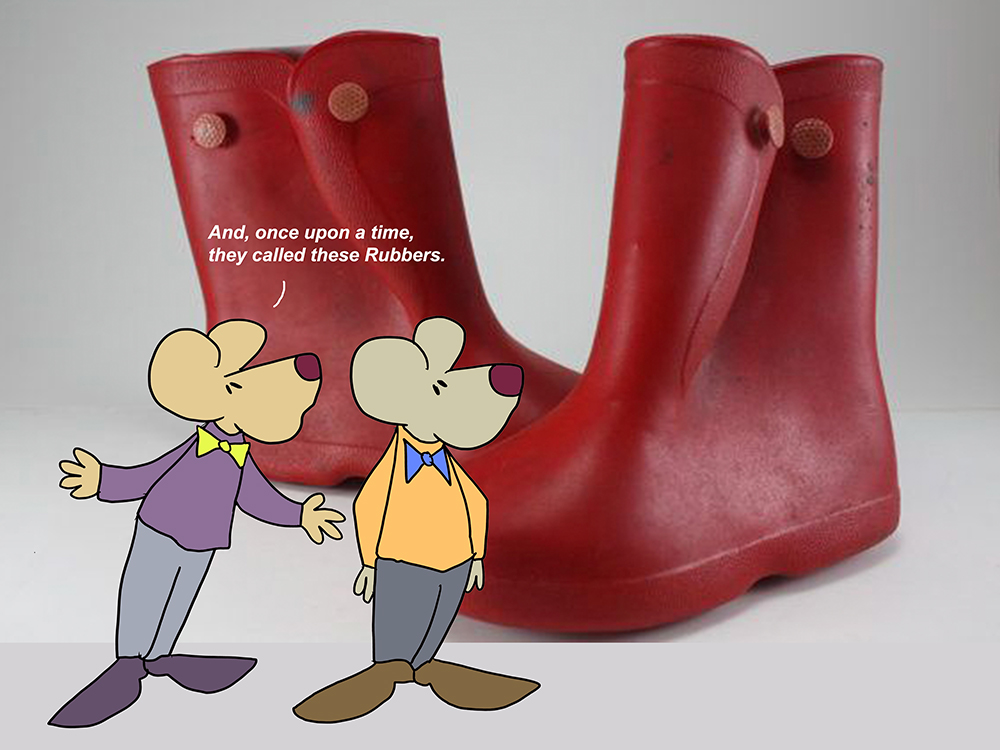As I Google the walking directions, I find out now that it was exactly 8/10 of a mile from my childhood home’s front door to Our Lady of Mercy grade school.
Not the whole five miles, as I remembered it was. Even still, a nice walk on nice days. And that is exactly what I did. But by and large, we walked to and from school. As we all know, it isn’t always sunny and warm in Ohio. There were days when it rained or snowed when we walked that path.
And that is why I am thankful for Mr. J.W. Goodrich. It was on this date, February 4, 1824, that Mr. Goodrich introduced rubber galoshes to the world.
At least, that is what this history installment read: “J W Goodrich introduces rubber galoshes to public.”
But as I searched for more information about J W, I came up short. I found one, in an obituary, which read:
J.W. Goodrich
Tullahoma, TN — Service 1 o’clock Friday, October 3, 2014, at Mt. Zion Baptist Church. J.A. Welton & Son Funeral Home.
People were asked to plant trees in his or her memory, whoever that JW was. But it wasn’t our galoshes guy.
The mystery remained. Who invented those galoshes? The ones that I strapped over my shoes, allowing me to jump in big puddles or forge snowy mounds?
There are records of an inventor by the name of Alvin Longo Rickman. He received a patent for an overshoe in 1898. But little information is available on him and his part in this caper.
Another account tells of a legend of an Englishman named Radley. This legend doesn’t even have a first name. Anyway, it states that invented galoshes. It tells the sad story about how he suffered from rheumatism and wanted to keep his feet dry. And then, one day, while keeping his rheumatic feet propped up, he was reading a copy of De Bello Gallico by Julius Caesar.
This did not cause him to create the Caesar Salad. No. Instead, he noticed a description in the book, telling of protective cloth overshoes called “gallicae.” He decided to utilize this idea. Purportedly, he patented cloth overshoes reinforced with rubber to keep his little footsies dry.
Again, the information on this guy Radley is sketchy at best. That legend may only be a tall story. Besides, who reads Caesar?
An encyclopedia entry states that boots can be seen in a cave painting from 13,000 years ago. I am no Rennaisance woman, but boots in a cave painting?
That same article tells us of the Inuits of Alaska and North America. It seems they imitated nature to create the perfect, weatherproof boot. Those Inuits noticed those toasty warm polar bears with their dense fur. So they shot the bears and took the complete paws and legs of these bears, and wore them as boots. The claws still attached,, for traction, I suppose.
The encyclopedia entry noted Egyptians, Amazonians, and many others as coming up with a form of boot overshoe throughout the ages.
But I want to know about those rubber galoshes.
Some point to Charles Goodyear, king of vulcanized rubber. He did not found the Goodyear Tire Company, but they named it after him. And in most articles about him, there is no mention of an overshoe.
So I pause.
I remember pulling those rubber boots over my shoes. Through the years, I had a red pair and a yellow pair. Both had a little elastic fastener at the top that would latch to a little button on the other side.
I loved wearing galoshes, although, I must admit, sometimes I’d get a little carried away in puddles, and I get splashes up and over the top.
But one challenge about galoshes was taking them off. More often than not, my shoe would be left behind, in the depths of that galosh. Pulling it out always created some sort of weird vacuum, and in the end, would make a “thhwok” noise upon extracting the shoe.
Today, I am thankful for all those things that help us walk along our way, no matter who invented them.
==========
“The unthankful heart discovers no mercies; but the thankful heart will find, in every hour, some heavenly blessings.”
― Henry Ward Beecher
=========
“Express gratitude for the greatness of small things.”
― Richie Norton
=========
“When eating fruit, remember the one who planted the tree.”
— Vietnamese Proverb
=========
Do you have a rubber? On your foot?
